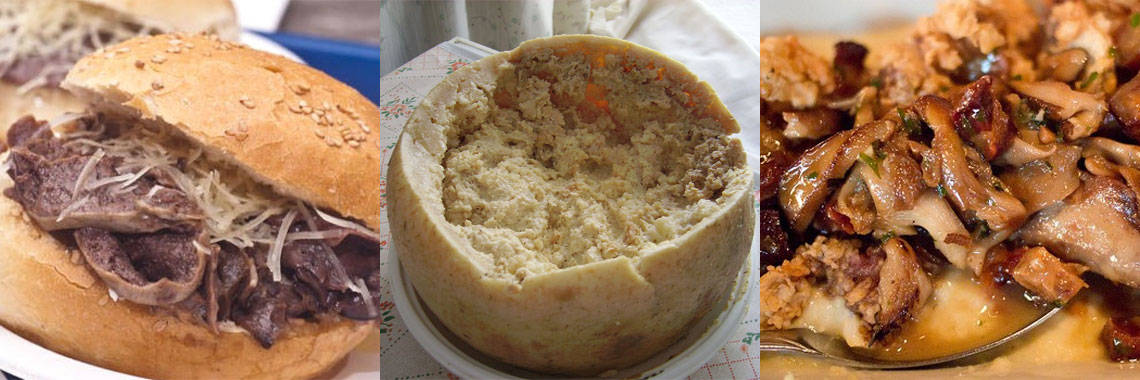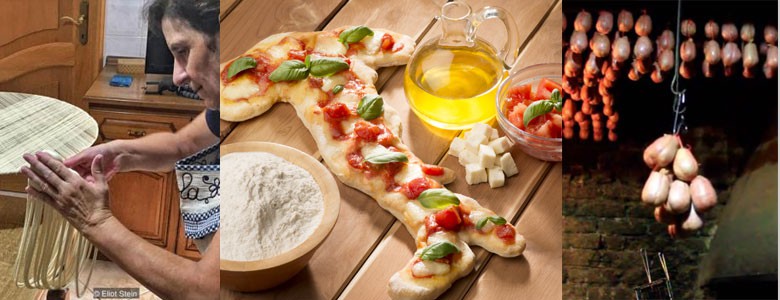We have a little test for you: think of Italian food and close your eyes for a couple of seconds to “see” what pops into your imagination…
Chances are that your foodie frenzy had you salivating over pizza, spaghetti or fettuccine with a variety of sauces, lasagna, gelato, Fiorentina steak, and some other famous to moderately-known dishes. Have you ever wondered about lesser known specialties from around the boot?
Today’s article provides you with some food for thought, opening a new world of ideas, flavors and traditions that will have you planning your next original foodie vacation in Italy!
Let’s begin with one of the rarest recipes in the world, the su filindeu (the name means “the threads of God”). It’s so difficult and time-consuming to prepare, that for 300 years only the women of a single Sardinian family knew how to make it!
BBC Travel correspondent Eliot Stein had the pleasure of traveling to this beautiful island and meeting Paola Abraini, who wakes up every day at 7am to begin making this pasta. The recipe is known only to her, to her niece and to her sister-in-law. In fact, for more than three centuries the recipe and technique have only been passed down through the women in Abraini’s family.
The engineers from Barilla tried to reproduce her technique with a machine, and failed. And it’s no wonder, as Paola explains herself with simple words:
“Many people say that I have a secret I don’t want to reveal, but the secret is right in front of you. It’s in my hands.”

Paola Abraini prepares Su Filindeu, Italy’s rarest pasta. Photos by Eliot Stein BBC Travel.
Su filindeu is made by pulling and folding semolina dough into 256 perfectly even strands with the tips of your fingers, and then stretching the needle-thin wires diagonally across a circular frame in an intricate three-layer pattern. It has become a sort of sacred dish that has only been served to the faithful who complete a 33-km pilgrimage on foot or horseback for the Feast of San Francesco. Paola worked five hours every day for one month to make 50 kg of pasta in occasion of this traditional religious festival in October 2016!
Since neither of Paola’s daughters have daughters of their own, and they lack the passion and patience of their mother, su filindeu has become the world’s most endangered pasta, according to the Slow Food International’s Ark of Taste, an initiative that aims to preserve the world’s rarest culinary traditions.
In an unprecedented move to safeguard this gastronomic art form and piece of cultural identity, Paola has tried to teach the recipe to girls outside her family. Unfortunately, however, all participants (so far) have left the course because of the amount of time and work required for preparing the dish. Recently, Paola began making su filindeu for some restaurants in Nuoro (Sardinia), offering non-pilgrims a chance to taste it for the first time. [You can read the entire article by Eliot Stein on BBC Travel.]
While the su filindeu is little known because of how rare it is, other Italian dishes are not very famous abroad because of their… “weird”, unusual character. But for locals they are a source of pride and a reminder of their culinary history and traditions. They are also a source of entertainment, as some visitors tend to have curious reactions when they hear the ingredients behind the dishes. But those who taste these local specialties, usually agree on how unusually delicious they are!
The pani câ meusa is typical of Sicilian street food, a dish exclusive to Palermo. It is a sesame-coated sandwich seasoned with calf spleen and lung that have been boiled and then fried in lard before being scooped into soft bread rolls. You can choose whether you want your sandwich to be ‘maritatu’ (married), i.e. combined with caciocavallo or ricotta cheese; to be ‘schettu’ (single), i.e. without any seasoning; or enriched with a sprinkle of lemon juice.

Unusual Dishes: Pani câ meusa by taccuinistorici.it, Casu Martzu by Shardan, Cibreo by gustoblog.it
In Tuscany, you find one of Catherine de Medici’s favorite dishes. The great granddaughter of Lorenzo il Magnifico and wife of Henry II of France, who was also one of the most important women of the Renaissance, loved Cibreo. This ancient Florentine soup is made with chicken livers, rooster testicles (also known as beans) and the comb (or crest) of chicken! It must be served steaming hot and eaten at once.
Would you eat cheese with worms inside? It certainly has an inimitable taste! Back in Sardinia you can find the casu frazigu (or casu martzu), or traditional Sardinian sheep milk cheese that contains live insect larvae. Casu martzu is believed to be an aphrodisiac by Sardinians, who often cut into thin strips and spread it on moistened local flatbread (pane carasau), enjoying it with a strong red wine. You can decide whether you want to eat the cheese with the live maggots or whether to remove them. Similar cheeses can be found in other regions of Italy too, for example: marcetto in Abruzzo, saltarello in Friuli Venezia Giulia, furmai nis in Emilia Romagna, and frmag punt in Apulia.
In central Italy, across the regions of Umbria, Marche, Lazio and Abruzzo, when strolling along markets, restaurants and norcinerie, you might notice ball-shaped cold cuts hanging here and there as decoration or for sale. Named coglioni di mulo (or mule’s balls), in reality they have nothing to do with the testicles of the humble animal that, for centuries, has helped the Apennine mountaineers in transporting their heavy loads. The name simply derives from the shape, and it is believed that its origins are tied to the consumption of sausages made from mule meat in the old days. They are originally from Norcia in Umbria. Coglioni di mulo are made from lean pork, which is finely minced and then stuffed into natural pig casings with a piece of lard, tied to a wedge of beech. Want to enjoy them like many locals do? Taste this delicacy after it has soaked in red wine for 48 hours!
Authentic foodie journeys in Italy
Would you like to learn more about the ancient and rare recipe of “the threads of God”, su filindeu? Do you dream about expanding your foodie knowledge beyond the normal, tasting the flavors of unusual local traditions? At Italian Special Occasions DMC, we can design foodie travel journeys according to what your taste buds and your curiosity command… contact us now!




